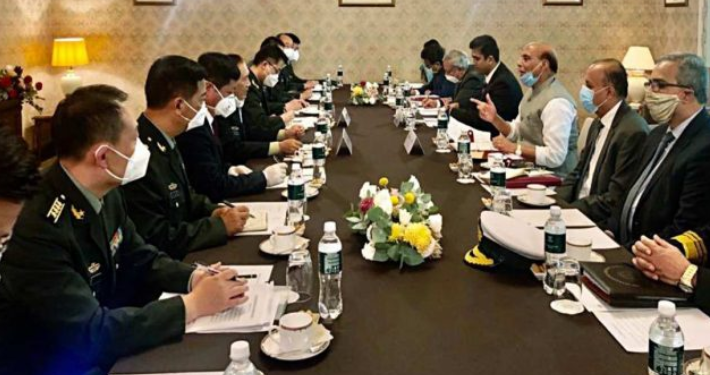Dr. D.K. Giri
Defying predictions by some observers and experts, India is participating in the Shanghai Cooperation Organisation meeting (SCO) in Russia. Defence Minister Rajnath Singh was there, his second visit to the country in the last two months, and met his Chinese counterpart, apparently at latter’s behest. Foreign Minister S. Jaishankar has also gone and met his Chinese counterpart.
New Delhi decided in favour of participation for perhaps two reasons. One, keep the Chinese engaged in a dialogue until normalcy is restored on the LAC; and secondly, to have the Russians on our side, even notionally. At any rate, the bulk of our defence arsenals still come from Russia. India’s participation in SCO, however, gives mixed signals about our foreign policy. On the one hand, it is in keeping with realpolitik as India is still not ready for a successful military operation to push Chinese back from our side of the LAC. On the other, New Delhi seems to be mixing up dialogue diplomacy with both deterrence and use of force, the language the Chinese understand.
Comparing our China approach with our dealings with Pakistan, we have ruled out any dialogue as long as Pakistan abates cross-border terrorism. The same logic and principle should apply to China which occupies our territory. We go hammer and tongs on Pakistan as we have a decisive military edge. With China, the reverse is the case. Our military and political leaderships have been obsessed with Pakistan and have failed to keep track of the upward trajectory of PLA’s military capabilities. Such oversight and deficit could be rectified with renewed and fresh diplomacy.
Alas, on China, we have not only fallen short in diplomacy, but it is also that the present Ladakh crisis has exposed the vacuity of India’s policy-making, whereas, driven by its economic and military power, China’s diplomacy rests on a show of strength and it has no time for talks or tantrums. India seems to have no matching answer to this approach.
Coming back to the SCO meetings, in Russia, the current meeting is called Exercise Kavkaz-20, where 13000 troops from around 20 countries including eight members of the SCO will participate in a joint military exercise from 15-20 September. It is a saving grace that India decided against sending the troops to this activity where Chinese and Pakistani troops are there.
How ironical is it that members of a security alliance like SCO largely headed by China are under threat by the same country! SCO meeting is taking place when China and India are in an active military conflict. Again, to draw a parallel, India boycotted and scuttled the 19th SAARC summit in the wake of the Uri terrorist attack in 2016. India accused Pakistan of its involvement in the Uri attack. Yet, India went ahead to SCO in our national interest.
Let us look at the defence minister’s participation and its outcome so far. Rajnath Singh met Wei Fenghe, Chinese defence minister and the state counsellor. What is not in public domain is the likely Russian hand in brokering such meetings on the sidelines of the SCO. But what is the outcome? While both sides profess to maintain the lines of communication, both at military and diplomatic levels, the statements before and following the meeting reek of belligerence and obduracy. After the meeting, China said, “India is entirely responsible for the border stand-off in Ladakh and China will not lose an inch of its territory”. It called on India to earnestly implement important consensus reached by President Xi and Prime Minister Modi. They insist on resolving the issues through dialogue and consultation.
The Indian side came out with an equally terse statement, the action of the Chinese troops, amassing of troops, aggressive behaviour, attempts to unilaterally alter the status quo wherein violation of the bilateral agreements. It added, “There should be no doubt about our determination to protect India’s sovereignty and territorial integrity” Foreign Minister S Jaishankar has been consistently pleading that the two countries should resolve their issues diplomatically. A bloody conflict is not good for either of the parties. But do we really comprehend Chinese diplomacy?
Before we touch on the art of Chinese diplomacy what is the issue that challenges our strategic ingenuity at present? Talks between our forces have reached the fifth round. From the military sources, de-escalation or pulling back will only happen once the Indian army reconciles to the PLA’s new position on the ground. New Delhi finds it hard. In the past four months, starting from May, China has moved LAC in to Indian territory, some 4.5 km deep, in places.
On Chinese diplomacy, they follow the legendary strategists Sun Tzu, the author of the Art of War. He has given a lot of clues to tackle the enemy. One that China seems to follows vis-à-vis India is, “the whole secret lies in confusing the enemy so that he cannot fathom our real intent”. We have Chanakya. Understanding Sun Tzu, will certainly stand in good stead for Indian diplomacy. So far, we have adhered to Indian ethos and principles, but not responded effectively to the Chinese strategy. Are we short of China hands in South Block?
To sum up, Indian diplomacy must engage beyond bilateralism with China. Even in military option, Indian should not be one-to-one with China. New Delhi must draw the attention of the world and join others in calling China a threat to world security. It should, along with other countries play the Tibet, Taiwan, Hong Kong card, even talk about other territories like Yunnan and East Mongolia occupied by China. Like Hitler picked on Poland first in the World War Ii, India should project itself as an innocent victim of Chinese aggression. If the world keeps quiet, the bell will toll for them next. One wonders why India is reticent on globalising the Chinese nefarious aggression on our border.
The writer is Professor of International Politics, JMI. INFA






































